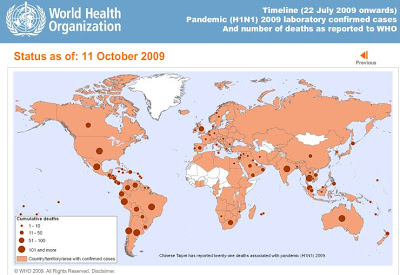
China has had far fewer deaths from H1N1 and has limited and delayed the spread of H1N1.
China’s strategy for fighting swine-flu is “resource intensive.” But China’s strategy worked to greatly slow the spread of swine flu infections in their country; Australia’s strategy didn’t do the same for their country. China’s way of fighting the pandemic was to greatly limit its spread at the start. That doesn’t mean they caught every case. It means they caught every case that came to the attention of a physician or hospital. The CDC pandemic-fighting model is based largely on analysis of the 1918 swine flu pandemic. China’s model is based on empirical observations of the way ‘airborne’ or aerosolized infectious disease first spreads from country to country in the 21st Century; namely, via globalized, heavy-volume commercial airline travel. There is no way to erase the data on China’s success at doing the Number One thing a national pandemic fighting plan is supposed to do: greatly slow the spread of the disease in a country.
Report from the summer of 2009 on the H1N1 procedures:
When the plane lands, current procedure is that four medical personnel come on board and check everyone’s temperature with a very fast “ear” thermometer. We were on a smaller plane and waited in total about 35 minutes until they were finished and cleared the plane so that we could all leave.
China has far fewer cases relative to India, Australia, and the United States. The United States now.
China had ignored the World Health Organization recommendation to not test for H1N1 and not try to institute quarantine of sick inbound travellers.
27 page document that discussed the options for managing H1N1. At the end of it:
In the face of the current situation of the new influenza A(H1N1), WHO does not currently recommend international border closures or international
travel restrictions.

Brian Wang is a Futurist Thought Leader and a popular Science blogger with 1 million readers per month. His blog Nextbigfuture.com is ranked #1 Science News Blog. It covers many disruptive technology and trends including Space, Robotics, Artificial Intelligence, Medicine, Anti-aging Biotechnology, and Nanotechnology.
Known for identifying cutting edge technologies, he is currently a Co-Founder of a startup and fundraiser for high potential early-stage companies. He is the Head of Research for Allocations for deep technology investments and an Angel Investor at Space Angels.
A frequent speaker at corporations, he has been a TEDx speaker, a Singularity University speaker and guest at numerous interviews for radio and podcasts. He is open to public speaking and advising engagements.


